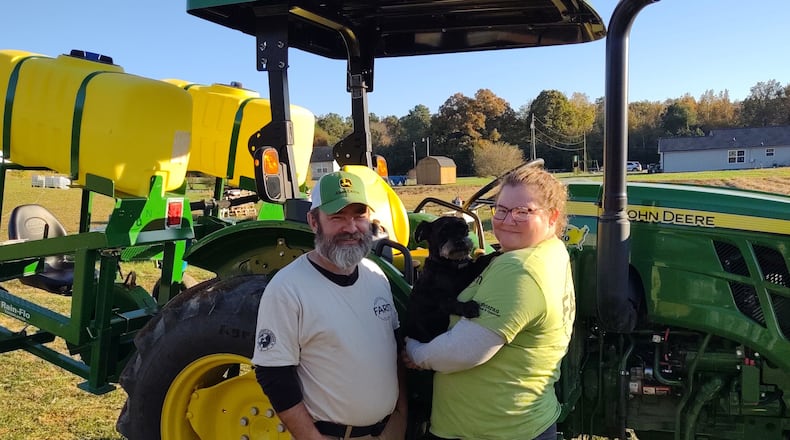Sometimes, farming requires a leap of faith. Possessing a healthy dose of optimism and innate curiosity also are good qualities.
It was a combination of those traits that led Katie Bridges of Chewy’s Backyard Farm in Buchanan, just east of the Alabama state line, to try her hand at growing saffron.
She and her husband, Dave, started their one-and-a-half acre backyard farm in 2017. They named their farm for Chewy, their 11-year-old miniature schnauzer. This time of year, there are rows of the usual fall crops, such as collards, kale and Swiss chard.
This year, they felt ready to branch out a little.
For Dave, branching out meant becoming a beekeeper.
And, for Katie? It meant deciding to try growing saffron, in hopes of finding a commercial market for a spice that most expect to purchase from growers around the Mediterranean.
It was a 2018 article in Hobby Farm Magazine, about the North American Center for Saffron Research and Development at the University of Vermont, that planted the idea.
“Dave and I each have our own pet projects, and we support each other completely,” Katie Bridges said. “When I mentioned my idea, the first thing he asked was, ‘What’s saffron?’ And, then, he said, ‘That can be your thing,’ and so I began doing my research. I talked with people from the university and from Roco Saffron, a wholesale saffron corm seller in Holland.”
She asked the experts whether she could grow saffron in Georgia. Everything she learned helped her make the decision to give it a try. The Bridges agreed on how much they would invest in this experiment — $100 — and she ordered 100 corms from Holland.
Saffron is the stigma of the blossom of the fall-blooming Crocus sativus. There are three tiny, deep orange, thread-like stigmas in each flower. Bridges estimated all the stigmas from her 100 saffron corms would total about a gram. Saffron sells for about$20-$30 per gram. For the sake of comparison, a gram of granulated sugar is just about a quarter teaspoon.
With such a tiny spice crop, it’s good that all parts of the blossom can be put to use. The lilac-colored petals can be dried and used for potpourri, and the bright yellow stamens also can be dried and used for clothing dye. Bridges hopes to find a Georgia cotton grower or wool producer who would want to use her stamens to produce brilliant yellow textiles.
The university researchers suggested Bridges grow her corms in milk crates — safe from predators like moles, who find the plants tasty. Another benefit to growing them in milk crates was that the couple could load the crates on pallets and use a forklift to move those pallets into the barn if temperatures dipped too low. And, they could make sure the corms had well-drained soil and just the right amount of moisture.
Bridges found milk crates on Craig’s List, lined them with landscaping fabric, and filled them with mushroom compost. Five corms went into each crate, leaving room for them to grow and produce more corms, called “daughters,” which would offer more blossoms to harvest in future years, plus the possibility of a secondary crop — selling saffron corms to other farmers.
The corms went into the crates in early September. In mid-October, the corms first began to send up green shoots. On Oct. 28, the first blossom appeared.
The flower parts must be harvested on the day the crocus blooms, preferably before midday. This is not a crop you can plant and leave for a day or two.
Four weeks later, 106 blossoms had been harvested, which yielded 1.6 grams of stamens (for dye) and 0.9 gram of stigmas (for spice).
Every blossom had been cut carefully from the plants, then pulled apart by hand, and the petals, stamens and stigmas carefully laid on window screen to dry. That’s a lot of tending, for two people who farm while keeping full-time jobs and being full-time students, with Dave working on his third master’s degree and Katie earning her doctorate.
As she began harvesting, Bridges noted that the stigmas were very fragrant, and the fragrance seemed to grow stronger the more they dried.
Ironically, Bridges never had cooked with saffron: “It’s so expensive!” But, now, she’s had the chance to use her homegrown saffron in a Thanksgiving meal, putting a half pinch on the turkey, and in her husband’s favorite cheesecake.
The couple is making plans for next year, applying for a grant, so they can try new techniques and identify best practices for growing saffron commercially in Georgia. “We plan on purchasing and planting at least 750 more corms next season,” Bridges said. “If we get the grant, we will plant 1,000 more corms in 2020 and 1,000 corms in 2021.”
Even if they don’t get the grant, the daughters from this year’s crop will make next year’s larger, Bridges said, which means more milk crates, mushroom compost and, the farmers hope, more saffron.
RELATED:
Read more stories like this by liking Atlanta Restaurant Scene on Facebook, following @ATLDiningNews on Twitter and @ajcdining on Instagram.
About the Author
Keep Reading
The Latest
Featured





